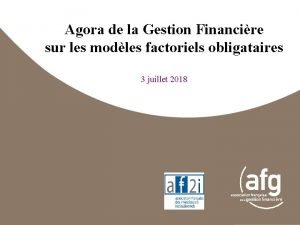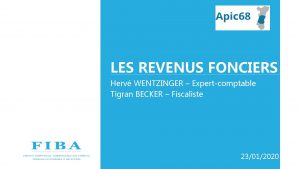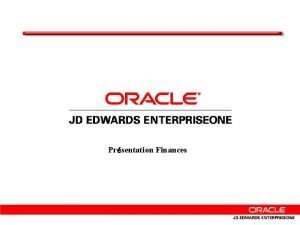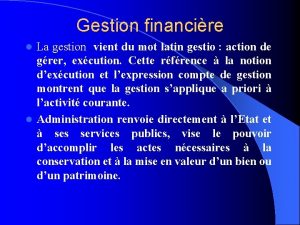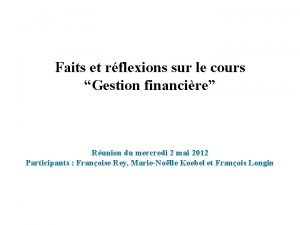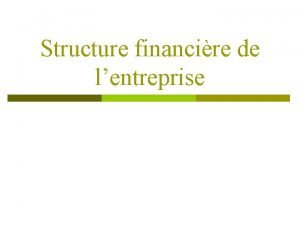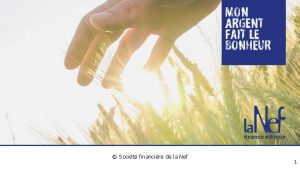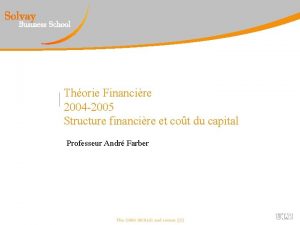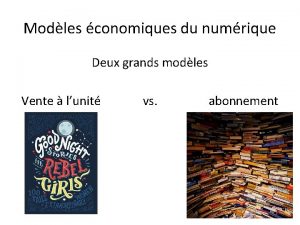Agora de la Gestion Financire sur les modles


































- Slides: 34

Agora de la Gestion Financière sur les modèles factoriels obligataires 3 juillet 2018

Intervenants : § Anthony Desrousseaux et Raul Leote de Carvalho, BNP Paribas AM § Jean-Charles Bertrand, directeur des investissements multi -actifs d’HSBC Global Asset Management, et professeur affilié à HEC § Jean-François Boulier, Président du Comité de Pilotage des Agoras de la Gestion de l'AFG et Président de l’Af 2 i

Factor-based strategies in credit Anthony Desrousseaux et Raul Leote de Carvalho, BNP Paribas AM

FACTOR-BASED STRATEGIES IN CREDIT BNPPAM – MAQS Quant Fixed Income OLIVIER LAPLENIE - BNPPAM July 2018 MARCH 2018 MARKETING COMMUNICATION FOR PROFESSIONAL INVESTORS

Biographies of the speaker Anthony Desrousseaux: Quant Fixed Income Portfolio Manager - 13 years with BNP Paribas Asset Management 5 years in Portfolio Management Previously Credit Structurer in New-York then Paris Graduated from Telecom Sud. Paris (1997), Chartered Financial Analyst (2008) BNPPAM – Multi Asset Quant & Solutions - Key figures - 13 professionals (8 Portfolio Managers) dedicated to quantitative solutions across all asset classes * Supported by a transversal Quant Research team (27 professionals) for quantitative research * Managing 10 bn EUR of asset in quantitative strategies, of which over 3. 1 bn EUR in Fixed Income * Provider of factor-based solutions in equities since 2008 and in fixed income since 2009 * Source: BNP Paribas AM, as of end of 2017 Agora de la Gestion Financière - AFG - Af 2 i

1 FACTORS IN FIXED INCOME : WHY AND HOW? Agora de la Gestion Financière - AFG - Af 2 i P 2のご留意事項をご確認ください。

Understanding drivers of risk and return Breaking down asset risks and returns ALPHA BETA Traditional beta Directional market risk Factor premia Unexplained returns § In equities: beta to market cap indices § In fixed income: duration and credit risk Factor exposure § Explicit factor investment § Indirect exposure to factors Examples § In equities: traditional indices (MSCI World, S&P 500, STOXX Europe 600) § In fixed Income: Sovereign, Investment Grade & High Yield, short/long duration indices § § § Value / Carry Low Risk Quality / Fundamentals Momentum Size Other alpha § Market timing § Manager skill (nonsystematic) § Discretionary stock/bond picking (not style-based) Source: BNP Paribas AM, for illustrative purpose only Agora de la Gestion Financière - AFG - Af 2 i

Our investment philosophy Capturing pure alpha from risk-controlled factors A fully systematic approach with a human supervision - Efficient on large investment universes - A disciplined and transparent investment process - The portfolio manager is key from strategy design to portfolio execution A pure factor-based approach building on in-house research: - Focusing on the specific drivers of each market segment - Aiming to separate directional risks from factor alpha Risk oriented, to: - Have precise control over the risk allocated to each sub-strategy - Avoid taking unwanted tracking error - Allow full customization to match the constraints of investors Agora de la Gestion Financière - AFG - Af 2 i

The main research findings underpinning our approach Demystifying Equity Risk-Based Strategies: A Simple Alpha Plus Beta Description – September 2011 § Main findings: We considered five risk-based strategies: equally-weighted, equal-risk budget, equal-risk contribution, minimum variance and maximum diversification. All five can be well described by exposure to the market-cap index and to four simple factors: low-beta, small-cap, low-residual volatility and value. è Investors should focus on factor-based strategies Inter-Temporal Risk Parity: A Constant Volatility Framework for Factor Investing – November 2014 § Main findings: An inter-temporal risk parity strategy re-balances the portfolio to the level of leverage required to target a constant ex-ante risk over time. The benefits of the inter-temporal risk parity strategy are more important for equity and foreign-exchange factors, with the strongest volatility clustering and fat tails. è Risk parity across factors (= risk budgeting approach) provides improved risk-adjusted returns Low-Risk Anomalies in Global Fixed Income: Evidence from Major Broad Markets – September 2013 § Main findings: In this paper we present the most compelling empirical evidence yet of a low-risk anomaly in fixed income markets. We show that portfolios invested in bonds with the lowest risk would have delivered the largest positive alpha and highest Sharpe ratios and portfolios invested in riskier bonds would have delivered the most negative alpha and lowest Sharpe ratios. è The Low-risk factor can be extended to fixed income Diversify and Purify Factor Premiums in Equity Markets – January 2017 § Main findings: We consider a number of portfolio construction approaches designed to capture factor premiums with the appropriate levels of risk controls aiming at increasing information ratios. We show that information ratios can be increased by targeting constant volatility over time, hedging market beta and hedging exposures to the size factor, i. e. neutralizing biases in the market capitalization of stocks used in factor strategies. è “Purifying” factors improves risk-adjusted returns Agora de la Gestion Financière - AFG - Af 2 i

Fixed income factors overview Fixed Income factor themes/style Carry (value) Fundamentals Momentum Low risk Looking for attractive riskadjusted carry Based on nonprice related data (balance sheet, macro…) Focusing on market dynamics and sentiment Targeting securities with the best return-to-risk Government bonds Forex Corporate bonds Source: BNP Paribas AM, as of end of December 2017. For illustrative purposes only Agora de la Gestion Financière - AFG - Af 2 i

2 MULTI-FACTOR CREDIT: SELECTING FACTORS Agora de la Gestion Financière - AFG - Af 2 i

Factor selection Key characteristics required before selecting a factor ► Explanatory power: We favor factors that are key drivers of fixed income markets, in particular with a strong academic backing and an economic/market rationale ► Sustained performance: The premium associated to the factor needs to be persistent through time ► Absence of bias: There should be a balanced contribution from all components to the performance of the factor (i. e. no structural over/under-weight to a specific country/currency that explains the performance) ► Ability to exploit the factor: You have to be able to efficiently capture the factor premium, which requires a reasonable turnover level and to be based on reliable data ► Complementarity: We favor factors that are uncorrelated with other factor premiums, both on average and in the tail of the distributions (i. e. with drawdowns that do not occur simultaneously) Agora de la Gestion Financière - AFG - Af 2 i

Testing Factors How do we find and test factors ? ► Ideas ► Ratios used by credit analyst, agencies: Leverage ratios, coverage ratios ? ► Ratios used by equity factor models: Equity price momentums, equity volatility ? ► Ratios linked to bonds markets ? ► Collecting Data ► Coverage for a full credit benchmark (thousands of bonds/issuers) ► How to map a bond to an equity ? Systematic mapping, manual mapping ► Back testing from 2000 Agora de la Gestion Financière - AFG - Af 2 i

Scoring a Factor From the bond to the score Mapping Bond Obligor Data Collection Bond To Score for one Factor Financial Reports Market Data Normalization Factor Score Factor Value Agora de la Gestion Financière - AFG - Af 2 i

Illustrative example: cumulated performance per quintile § General idea: focusing on bonds that have an attractive valuation in regards to their risk § Main indicator(s): OAS* / distance to default Performance per quintile on a USD IG universe: OAS to distance to default * OAS: Option-adjusted spread Source for the chart: BNP Paribas AM, as of December 2017. The simulations are the result of estimates of BNP Paribas AM based on various parameters used and should not be viewed as a promise of future results of the fund. As a consequence, data contained herein are indicative only and are provided solely for information purposes. Past performance or achievements are not indicative of current or future performance. Agora de la Gestion Financière - AFG - Af 2 i

Systematic scoring of corporate bonds A unique blend of fixed income, equity and fundamental factors Factor scoring: ► Bond are scored on each factor between -2 and +2 ► Investment Universe: Euro Inv. Grade, USD Inv. Grade, USD High Yield bonds ► Scorings are sector-neutral in order to avoid structural biases ► A proprietary approach is used to rank bonds to a pool of bonds with similar risk (duration, maturity) Style / Theme Factors Value 25% Quality 25% Momentum 25% Low Risk 25% Spread / Distance to Default Equity book-to-price EBITDA*/Debt Financing Cash / Debt Equity 12 M/1 M Asset Growth 5 Y Debt to Market Cap Distance to Default For illustrative purposes only. *EBITDA : earnings before interest, tax, depreciation and amortization This is for illustrative purposes only and should not be used as a basis for making any specific investment, business or commercial decisions

Example: score skyline of a bond selected by the model Example 1: attractive value and quality, with below average risk Score skyline of bond 1 Value Quality Momentum Low risk Source for the chart : BNPPAM as of end of February 2018 This is for general information only and should not be used as a basis for making any specific investment, business or commercial decisions. Any economic and market trend, prediction, projection or forecast is not necessarily indicative of the future or likely performance of the funds. Overview : ► ► Value: Good - the bond under consideration exhibits an attractive spread-to-risk ratio Quality: Good - Schneider ranks better than its sector peers regarding its dependence on financing flows Momentum: Neutral - both the equity price momentum and the asset growth are roughly neutral Low risk: Good - its financial leverage is good relative to its sector peers Agora de la Gestion Financière - AFG - Af 2 i

Example: score skyline of a bond not selected by the model Example 2: good value but poor quality, momentum and risk Score skyline of bond 2 Value Quality Momentum Low risk Source for the chart : BNPPAM as of end of February 2018 This is for general information only and should not be used as a basis for making any specific investment, business or commercial decisions. Any economic and market trend, prediction, projection or forecast is not necessarily indicative of the future or likely performance of the funds. Overview : ► ► Value: Good - the bond under consideration exhibits a high spread relative to its risk Quality: Poor – both quality factors score poorly relative to the sector Momentum: Poor – the equity price momentum suggest negative sentiment Low risk: Poor - its financial leverage looks high compared to sector peers Agora de la Gestion Financière - AFG - Af 2 i

Factor statistics (pro-forma, USD Investment Grade) Alpha based on excess returns vs Treasuries - Information Ratio by Quintile Q. Worst Q 2 Q 3 Q 4 Q. Best FCF/Debt -0. 59 -0. 24 -0. 05 0. 15 0. 60 Financing. Cash/Debt -0. 29 -0. 76 -0. 24 0. 85 0. 47 OAS/Distance to default -1. 75 -1. 24 0. 13 0. 93 1. 59 Book/Price -1. 68 -0. 35 0. 29 0. 87 1. 29 Equity Momentum 12 M/1 M -1. 58 -0. 71 0. 50 1. 22 1. 41 Asset Growth 5 Y -0. 26 -0. 69 0. 27 0. 62 0. 26 Distance to default -1. 55 -0. 99 0. 20 0. 93 1. 50 Debt/Assets -0. 72 -0. 69 0. 18 0. 58 1. 03 Source for the table and chart: BNP Paribas AM, as of December 2017 The simulations are the result of estimates of BNP Paribas AM based on various parameters used and should not be viewed as a promise of future results of the fund. As a consequence, data contained herein are indicative only and are provided solely for information purposes. Past performance or achievements are not indicative of current or future performance.

4 PORTFOLIO CONSTRUCTION AND PERFORMANCE SIMULATIONS Agora de la Gestion Financière - AFG - Af 2 i

Portfolio construction and execution From factors to portfolio Building a portfolio while controlling risks relative to the benchmark ► Weight caps per bond and issuer for a well-diversified portfolio (minimum 100 -150 bonds) ► Robust optimization aiming to keep the average duration and spread close to benchmark ► Integration of customized constraints if applicable, notably ESG ► Use of derivatives to align the risk of portfolio (volatility) with the benchmark Ensuring smooth execution ► Monthly rebalancing at the start of each month ► Average one-way turnover of about 6 -7% per month arising from strong research efforts ► New bonds enter the portfolio only if their expected alpha is significantly higher than transaction costs ► Order execution within preset limits of bid/offer Agora de la Gestion Financière - AFG - Af 2 i

Overview of the selected bonds Scatter plot of the portfolio relative to the investment universe (USD Inv. Grade) Source for the chart: BNP Paribas AM, as of December 2017 The simulations are the result of estimates of BNP Paribas AM based on various parameters used and should not be viewed as a promise of future results of the fund. As a consequence, data contained herein are indicative only and are provided solely for information purposes. Past performance or achievements are not indicative of current or future performance. Agora de la Gestion Financière - AFG - Af 2 i 22

Average factor scoring of the portfolio (USD + EUR IG) Source for the charts and tables: BNPPAM as of end of March 2018. The simulations are the result of estimates of BNP Paribas AM based on various parameters used and should not be viewed as a promise of future results of the fund. As a consequence, data contained herein are indicative only and are provided solely for information purposes. Past performance or achievements are not indicative of current or future performance. Past performance or achievement is not indicative of current or future performance Agora de la Gestion Financière - AFG - Af 2 i

Performance (pro-forma simulation): USD IG Net of estimated transaction costs, gross of fees Source for the chart and tables: BNPPAM , Bloomberg, Bo. AML, as of end of December 2017 Hypothetical or simulated performance results are presented for illustrative purposes only and have many inherent limitations. Such results do not reflect actual portfolio returns or fees and are generally prepared with the benefit of hindsight. No representation is made that any portfolio will or is likely to achieve profits or losses similar to those shown. Please see Additional Disclosures for further information. Agora de la Gestion Financière - AFG - Af 2 i

Main risks associated to the strategy Interest rates risk: The risk category is justified by the investment mainly in Interest Rate instruments. The investor's attention is drawn to the fact that an increase in interest rates results in a decrease in the value of investments in bonds and debt instruments and more generally fixed income instruments. Credit Risk: This risk relates to the ability of an issuer to honour its commitments: downgrades of an issue or issuer rating may lead to a drop in the value of associated bonds. Liquidity Risk: This risk arises from the difficulty of selling an asset at a fair market price and at a desired time due to lack of buyers. Counterparty Risk: This risk is associated with the ability of a counterparty in an Over The Counter financial transaction to fulfil its commitments like payment, delivery and reimbursement. Derivatives Risk: When investing in over the counter or listed derivatives, the Fund aims to hedge and/or to leverage the yield of its position. The attention of the investor is drawn to the fact that leverage increases the volatility of the subfund. Agora de la Gestion Financière - AFG - Af 2 i

Disclaimer BNP PARIBAS ASSET MANAGEMENT FRANCE, “THE INVESTMENT MANAGEMENT COMPANY, ” IS A SIMPLIFIED JOINT STOCK COMPANY WITH ITS REGISTERED OFFICE AT 1 BOULEVARD HAUSSMANN 75009 PARIS, FRANCE, RCS PARIS 319 378 832, REGISTERED WITH THE “AUTORITÉ DES MARCHÉS FINANCIERS” UNDER NUMBER GP 96002. THIS MATERIAL IS ISSUED AND HAS BEEN PREPARED BY THE INVESTMENT MANAGEMENT COMPANY. THIS MATERIAL IS PRODUCED FOR INFORMATION PURPOSES ONLY AND DOES NOT CONSTITUTE: 1. AN OFFER TO BUY NOR A SOLICITATION TO SELL, NOR SHALL IT FORM THE BASIS OF OR BE RELIED UPON IN CONNECTION WITH ANY CONTRACT OR COMMITMENT WHATSOEVER OR 2. INVESTMENT ADVICE. THIS MATERIAL MAKES REFERENCE TO CERTAIN FINANCIAL INSTRUMENTS AUTHORISED AND REGULATED IN THEIR JURISDICTION(S) OF INCORPORATION. NO ACTION HAS BEEN TAKEN WHICH WOULD PERMIT THE PUBLIC OFFERING OF THE FINANCIAL INSTRUMENT(S) IN ANY OTHER JURISDICTION, EXCEPT AS INDICATED IN THE MOST RECENT PROSPECTUS AND THE KEY INVESTOR INFORMATION DOCUMENT (KIID) OF THE RELEVANT FINANCIAL INSTRUMENT(S) WHERE SUCH ACTION WOULD BE REQUIRED, IN PARTICULAR, IN THE UNITED STATES, TO US PERSONS (AS SUCH TERM IS DEFINED IN REGULATION S OF THE UNITED STATES SECURITIES ACT OF 1933). PRIOR TO ANY SUBSCRIPTION IN A COUNTRY IN WHICH SUCH FINANCIAL INSTRUMENT(S) IS/ARE REGISTERED, INVESTORS SHOULD VERIFY ANY LEGAL CONSTRAINTS OR RESTRICTIONS THERE MAY BE IN CONNECTION WITH THE SUBSCRIPTION, PURCHASE, POSSESSION OR SALE OF THE FINANCIAL INSTRUMENT(S). INVESTORS CONSIDERING SUBSCRIBING TO THE FINANCIAL INSTRUMENT(S) SHOULD READ CAREFULLY THE MOST RECENT PROSPECTUS AND KEY INVESTOR INFORMATION DOCUMENT (KIID) AND CONSULT THE FINANCIAL INSTRUMENT(S’) MOST RECENT FINANCIAL REPORTS. THESE DOCUMENTS ARE AVAILABLE ON THE WEBSITE. OPINIONS INCLUDED IN THIS MATERIAL CONSTITUTE THE JUDGEMENT OF THE INVESTMENT MANAGEMENT COMPANY AT THE TIME SPECIFIED AND MAY BE SUBJECT TO CHANGE WITHOUT NOTICE. THE INVESTMENT MANAGEMENT COMPANY IS NOT OBLIGED TO UPDATE OR ALTER THE INFORMATION OR OPINIONS CONTAINED WITHIN THIS MATERIAL. INVESTORS SHOULD CONSULT THEIR OWN LEGAL AND TAX ADVISORS IN RESPECT OF LEGAL, ACCOUNTING, DOMICILE AND TAX ADVICE PRIOR TO INVESTING IN THE FINANCIAL INSTRUMENT(S) IN ORDER TO MAKE AN INDEPENDENT DETERMINATION OF THE SUITABILITY AND CONSEQUENCES OF AN INVESTMENT THEREIN, IF PERMITTED. PLEASE NOTE THAT DIFFERENT TYPES OF INVESTMENTS, IF CONTAINED WITHIN THIS MATERIAL, INVOLVE VARYING DEGREES OF RISK AND THERE CAN BE NO ASSURANCE THAT ANY SPECIFIC INVESTMENT MAY EITHER BE SUITABLE, APPROPRIATE OR PROFITABLE FOR AN INVESTOR’S INVESTMENT PORTFOLIO. GIVEN THE ECONOMIC AND MARKET RISKS, THERE CAN BE NO ASSURANCE THAT THE FINANCIAL INSTRUMENT(S) WILL ACHIEVE ITS/THEIR INVESTMENT OBJECTIVES. RETURNS MAY BE AFFECTED BY, AMONGST OTHER THINGS, INVESTMENT STRATEGIES OR OBJECTIVES OF THE FINANCIAL INSTRUMENT(S) AND MATERIAL MARKET AND ECONOMIC CONDITIONS, INCLUDING INTEREST RATES, MARKET TERMS AND GENERAL MARKET CONDITIONS. THE DIFFERENT STRATEGIES APPLIED TO FINANCIAL INSTRUMENTS MAY HAVE A SIGNIFICANT EFFECT ON THE RESULTS PRESENTED IN THIS MATERIAL. PAST PERFORMANCE IS NOT A GUIDE TO FUTURE PERFORMANCE AND THE VALUE OF THE INVESTMENTS IN FINANCIAL INSTRUMENT(S) MAY GO DOWN AS WELL AS UP. INVESTORS MAY NOT GET BACK THE AMOUNT THEY ORIGINALLY INVESTED. THE PERFORMANCE DATA, AS APPLICABLE, REFLECTED IN THIS MATERIAL, DO NOT TAKE INTO ACCOUNT THE COMMISSIONS, COSTS INCURRED ON THE ISSUE AND REDEMPTION AND TAXES. ALL INFORMATION REFERRED TO IN THE PRESENT DOCUMENT IS AVAILABLE ON WWW. BNPPARIBAS-AM. COM 26

Factor-based investing : un développement contrasté Jean-Charles Bertrand, directeur des investissements multi-actifs d’HSBC Global Asset Management, professeur affilié à HEC

Factor-based investing : un développement contrasté § Succès pour les actions individuelles : plus de 300 papiers académiques et 200 facteurs déjà en 2014 (Harvey, Liu et Zhu) § Extension progressive aux autres classes d’actifs ü Asness, Moskowitz et Pedersen, « Value and Momentum everywhere » , 2013 ü Koijen, Moskowitz, Pedersen et Vrugt, « Carry » , 2013 § Une approche encore limitée sur le crédit : ü Robeco (2014), AQR (2017 et 2018) BNP (2014 et 2018)

Factor-based investing : stratégies factorielles ou quantitatives actives ? (1) Facteurs Définitions Value Spread vs Fitted spread – Spread / Distance to Default Carry OAS Momentum Excess return to Treasuries – Equity return Low Risk Leverage-Gross Profitability-Low Duration – DTS – DTY – Debt to Market cap Size Public debt size Defensive / Quality Ebitda / Debt – Financing Cash / debt

Factor-based investing : stratégies factorielles ou quantitatives actives ? (2) § Les définitions des facteurs Value et Low Risk / Defensive / Quality n’apparaissent pas évidentes : ü Le facteur Value ressemble plus à une stratégie quantitative active qu’à un facteur de « style » ü Ambiguité des facteurs Low Risk et Defensive / Quality ü Redondance avec les facteurs actions

Backtests : réalité ou illusion ? § Un constat : les coûts de transaction par unité de risque sont beaucoup plus importants que sur les marchés actions § Peu de transparence sur les hypothèses de coûts de transaction § Prise en compte de coûts de transaction variables en fonction de l’environnement ? § Les sources de prix standard (BVAL pour Barclays/Bloomberg , ICE pour Bof. A ML) ne reflètent pas toujours les conditions de marché § Possibilité de traiter ? ü Période de crise ü L’indice Iboxx Euro Liquid Corporate Bond comporte 40 titres ü Univers limité de CDS pour les positions short

Des explications convaincantes ? § Au-delà des backtests, il est primordial de trouver des explications aux primes liées aux facteurs : ü Primes de risque ü Anomalies / Explications Comportementales / Contraintes / Limits to Arbitrage § Besoin de mieux comprendre la nature des primes factorielles sur les marchés de crédit § « Who is on the other side ? » ü Seul le portefeuille de marché cap-weighted est macro-consistent: tous les investisseurs peuvent détenir le même portefeuille à l’équilibre ü Les stratégies factorielles ne sont pas macro-consistent ü Mieux comprendre pourquoi les primes ne sont pas arbitrées

Intervenants : § Anthony Desrousseaux et Raul Leote de Carvalho, BNP Paribas AM § Jean-Charles Bertrand, directeur des investissements multi -actifs d’HSBC Global Asset Management, et professeur affilié à HEC § Jean-François Boulier, Président du Comité de Pilotage des Agoras de la Gestion de l'AFG et Président de l’Af 2 i

Agora de la Gestion Financière sur les modèles factoriels obligataires 3 juillet 2018
 Agora modles
Agora modles Les composantes de la gar
Les composantes de la gar En quittant cette terre
En quittant cette terre Financire
Financire Communication modles
Communication modles Lester milbrath
Lester milbrath Modles
Modles Communication modles
Communication modles Https://gestion.parcoursup.fr/gestion/authentification
Https://gestion.parcoursup.fr/gestion/authentification Sance 8
Sance 8 Le style transmissif
Le style transmissif Les étapes de la gestion de projet
Les étapes de la gestion de projet Gestion de projet : les fondamentaux
Gestion de projet : les fondamentaux Gestion de projet : les fondamentaux
Gestion de projet : les fondamentaux Style de gestion de classe
Style de gestion de classe Cours sur les antennes
Cours sur les antennes Jai une question
Jai une question Chanson vetement anglais
Chanson vetement anglais Texte sur les nuages
Texte sur les nuages Exposé sur les kangourous
Exposé sur les kangourous Déficit imputable sur les revenus fonciers 4bb
Déficit imputable sur les revenus fonciers 4bb Cours sur les lysosomes
Cours sur les lysosomes Introduction sur les capteurs
Introduction sur les capteurs Cours sur les trames
Cours sur les trames Exposé sur le panda géant
Exposé sur le panda géant Biographie de victor hugo
Biographie de victor hugo Exercices sur les constituants alimentaires
Exercices sur les constituants alimentaires Action de la soude sur les métaux
Action de la soude sur les métaux Production écrite sur les nouvelles technologies
Production écrite sur les nouvelles technologies Annotations sur les copies
Annotations sur les copies Exposé pompier
Exposé pompier Introduction sur les matériaux de construction
Introduction sur les matériaux de construction Slidetodoc.com
Slidetodoc.com Introduction sur les tice
Introduction sur les tice Evaluation volcan
Evaluation volcan
